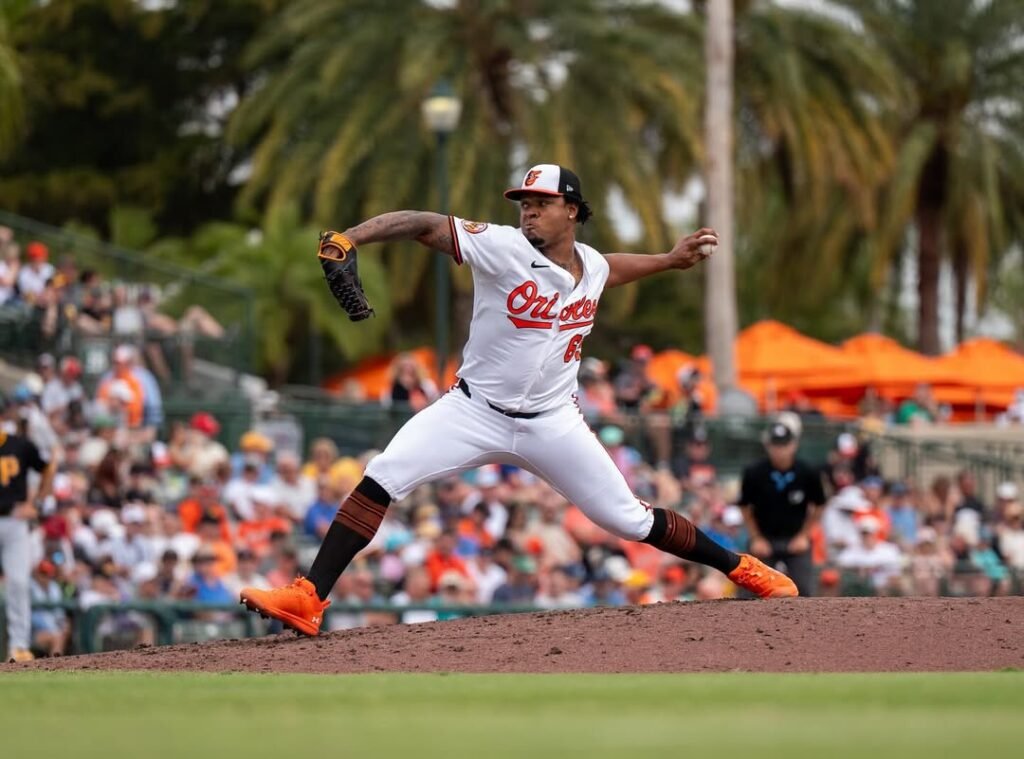The New York Mets just supercharged their playoff push. On July 25, they acquired left-handed reliever Gregory oto from the Baltimore Orioles for pitching prospects Wellington Aracena and Cameron Foster. The deal answered weeks of fan searches for bullpen help and instantly pushed Gregory Soto into the top tier of trending baseball names in the United States.
Why the Mets Needed a Hard-Throwing Lefty
New York’s bullpen led MLB in ERA through May 31. Then injuries and overuse struck. Since June 1, Mets relievers own a 4.52 ERA, twenty-third in the majors. Lefty balance vanished when A.J. Minter and Danny Young suffered season-ending injuries. Manager Carlos Mendoza had relied on Brooks Raley alone, a risky single-arm strategy in late innings.
President of baseball operations David Stearns outlined his priority on July 21: “We need dependable late-inning arms.” Four days later, the Mets landed Gregory Soto. Mission accomplished.
Gregory Soto’s 2025 Snapshot
The 30-year-old southpaw pairs a 97 mph sinker with an 87 mph slider. His velocity ranks among the game’s hardest for lefties. Baseball Savant places his whiff rate in the 94th percentile, proof that hitters rarely square him up.
Command remains the blemish. An 11% walk clip aligns with his career norm. Yet the Mets believe pitching coach Jeremy Hefner can refine his mechanics enough to trim free passes without sacrificing heat.
Contract Details and Tax Math
Gregory Soto avoided arbitration last winter, signing a one-year, $5.35 million pact. About $1.87 million remains due. Because the Mets sit in the top luxury-tax bracket, they pay a 110% surcharge, making Soto’s true cost roughly $3.93 million. Owner Steve Cohen agreed without blinking; bullpen insurance trumps tax pain during a pennant hunt.
Soto reaches free agency after the season, giving New York flexibility. If he thrives, the front office can discuss a multiyear extension. If not, he becomes a short-term rental whose departure frees payroll space.
Scouting Report: Stuff Over Stats
- Sinker (97 mph): Heavy arm-side run, late dive, ground-ball machine.
- Slider (87 mph): Hard sweep, plus whiffs, out-pitch to righties.
- Four-seam (97 mph): Elevated heat, tunnel effect with slider.
- Changeup (used rarely): Experimental, flashes 89 mph fade.
BrooksBaseball data shows Gregory Soto throws his sinker 53% of the time and slider 35%. That mix keeps the ball in the yard; his 0.50 HR/9 is a career best. When his release points align, hitters pound the ball into the dirt or swing through air.
How He Fits the Mets’ Bullpen Blueprint
Mets relievers feature right-handed flamethrowers Edwin Díaz, Adam Ottavino, and Drew Smith. Adding Gregory Soto gives Mendoza a left-handed counterweight for high-leverage pockets. Expect the manager to deploy Soto against Bryce Harper, Matt Olson, and Juan Soto in crucial NL East showdowns.
The depth chart now reads:
- Closer: Edwin Díaz
- Primary setup: Gregory Soto (L) / Ottavino (R)
- Bridges: Smith, Sean Reid-Foley, Reed Garrett
- Situational lefty: Brooks Raley
This arrangement shortens games to seven innings when the offense supplies a lead.
Prospect Price: A Balanced Gamble
Wellington Aracena, 20, carried a 2.38 ERA and zero homers allowed in Class A. Scouts love his heavy sinker but see years of development ahead. Cameron Foster, 26, split Double-A and Triple-A with a 2.97 ERA. His age limits upside. For a win-now Mets team, surrendering two unproven arms felt acceptable for immediate bullpen stability.
Baltimore, meanwhile, flips an impending free agent for controllable pitching depth—classic small-market asset management.
Home-Road Splits and Citi Field Forecast
Pitching at Coors Field once inflated Soto’s ERA during his Detroit and Philadelphia seasons. Camden Yards proved kinder, and Citi Field should be even friendlier. Statcast park factors favor pitchers, especially lefties who attack the third-base line. Expect his ground-ball lean to play well on Citi’s fast infield.
Historical Context: Soto’s All-Star Pedigree
The Dominican hurler collected back-to-back All-Star nods with Detroit in 2021 and 2022. He saved 30 games for a last-place Tigers squad, showcasing mental toughness in low-margin situations. The Mets value that resume. October crowds amplify pressure; Soto has heard louder boos in Philadelphia and tasted louder cheers in Comerica.
Injury History and Durability
Soto remains remarkably durable. He logged 69 appearances in 2023, 68 in 2024, and already 45 in 2025. His only injured-list stint came in 2021 for a finger fracture. That reliability appeals to a Mets club ravaged by arm ailments.
Statcast Indicators Point Upward
- Hard-hit rate allowed: 30.2% (career low)
- Barrel rate: 4.3% (94th percentile)
- Expected ERA (xERA): 3.28, outperforming actual 3.96
These metrics hint that better luck could shrink his ERA under Mets pitching guru Hefner.
Fan and Clubhouse Reaction
Social media exploded with fire emojis and optimism. Pete Alonso tweeted “Welcome to the fight, big lefty!” while Francisco Lindor posted a handshake GIF. In the clubhouse, players privately praised front-office aggression. They see management matching their World Series ambition.
Can Soto Secure an Extension?
If the southpaw flashes All-Star form, the Mets could dangle a two-year offer in November. Comparable late-inning lefties signed for $18-22 million recently. Soto’s age-31 season looms, making a multiyear safety net attractive for both sides.
Why This Trade Matters
Championship teams win tight games. Tight games hinge on bullpen execution. Gregory Soto brings swing-and-miss stuff, playoff experience, and left-handed balance precisely when the Mets need it. The cost in prospects feels reasonable against the backdrop of a wide-open National League.
The move also underscores Steve Cohen’s willingness to spend whatever tax dollars necessary. Fans demanded action; management delivered. Now it falls on Gregory Soto to justify the hype by owning the seventh and eighth innings in Flushing.
Read More: Explosive Ryan McMahon Trade Rocks Yankees Playoff Push

